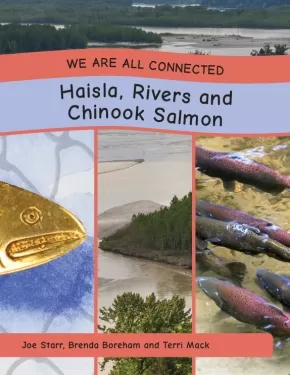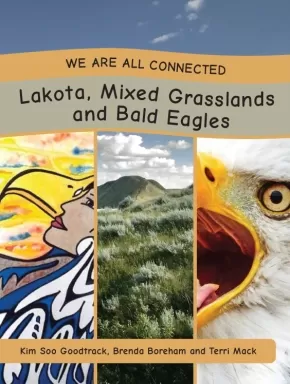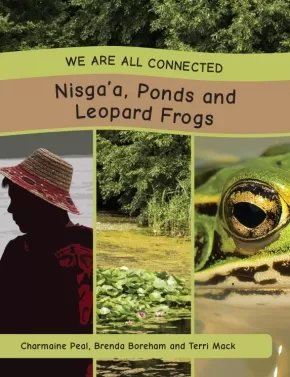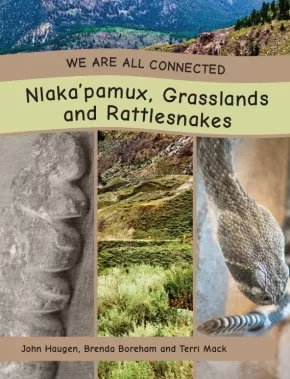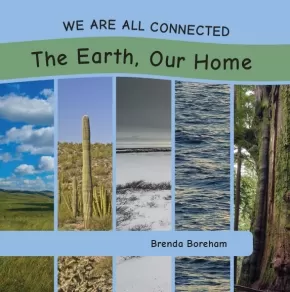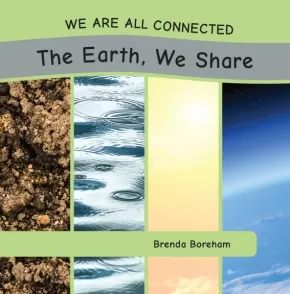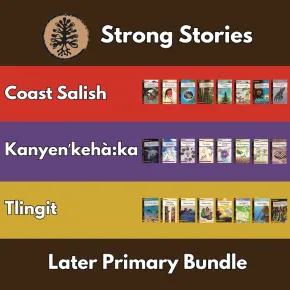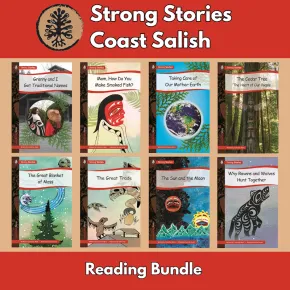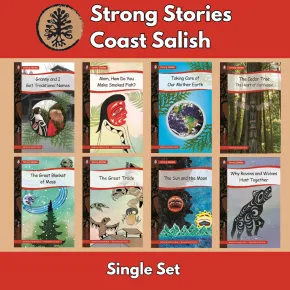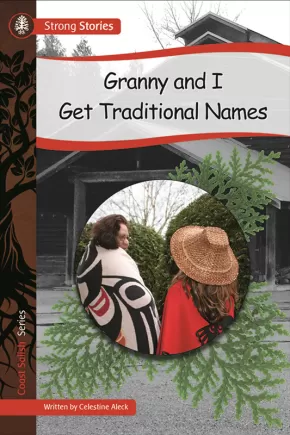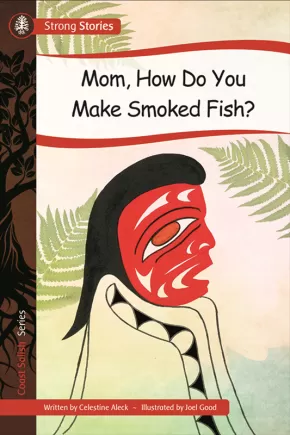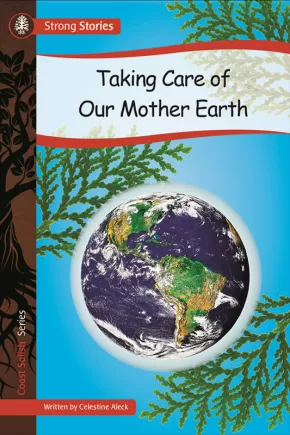
Grade 4
46
-
60
of
87 Results;
Sort By
Go To
of 6
We Are All Connected: Haisla, Rivers and Chinook Salmon
 $21.95
$21.95

Format:
Paperback
Text Content Territories:
Indigenous Canadian; First Nations; Haisla (Kitamaat);
ISBN / Barcode: 9781771742467
Synopsis:
Synopsis:
“We Are All Connected” is a series that explores how we all live together in a shared balance upon Mother Earth. Each book explores a specific ecosystem with a focus on one animal and its adaptations for survival within that ecosystem. Indigenous interviewees, each living within the same area, have responded to strategic questions as to how their community interacts with the land, their traditional territory. Explore each text with a sense of inquiry in mind.
8 We Are All Connected Titles Coast Salish, Coastal Rainforests and Cougars Haisla, Rivers and Chinook Salmon Inuit, Tundra and Ravens Lakota, Mixed Grasslands and Bald Eagles Métis, Wetlands and Mallards Nisga'a, Ponds and Leopard Frogs Nlaka'pamux, Grasslands and Rattlesnakes Sto:lo, Riparian Forests and Black Bears Each title covers the following curricular areas. Traditional storytelling and artwork begin each title from the focus Indigenous territory. Science: Biodiversity, classification, life cycles, food chains, food webs and connections between living and non-living things are just some of the science concepts included in each book. Social Studies: Contemporary and historical Indigenous cultural knowledge flows throughout each book. Local land forms, gatherings, harvesting practices and government are some of the social studies concepts included in each book.
2 Foundation Titles The two foundational books provide deeper understanding of the content of the “We Are All Connected” titles. We Are All Connected: The Earth, Our Home- explores biomes, ecosystems and biodiversity. We Are All Connected: The Earth, We Share- explores the interconnectedness between living and non-living things.
Authenticity Note: There is some Indigenous art in this book, such as a pendant carved by a Haida artist.
Additional Information
32 pages | 8.50" x 11.00" | ISBN: 9781771742467
We Are All Connected: Inuit, Tundra and Ravens
 $21.95
$21.95

Format:
Paperback
Text Content Territories:
Indigenous Canadian; Inuit;
ISBN / Barcode: 9781771742481
Synopsis:
Synopsis:
“We Are All Connected” is a series that explores how we all live together in a shared balance upon Mother Earth. Each book explores a specific ecosystem with a focus on one animal and its adaptations for survival within that ecosystem. Indigenous interviewees, each living within the same area, have responded to strategic questions as to how their community interacts with the land, their traditional territory. Explore each text with a sense of inquiry in mind.
8 We Are All Connected Titles Coast Salish, Coastal Rainforests and Cougars Haisla, Rivers and Chinook Salmon Inuit, Tundra and Ravens Lakota, Mixed Grasslands and Bald Eagles Métis, Wetlands and Mallards Nisga'a, Ponds and Leopard Frogs Nlaka'pamux, Grasslands and Rattlesnakes Sto:lo, Riparian Forests and Black Bears Each title covers the following curricular areas. Traditional storytelling and artwork begin each title from the focus Indigenous territory. Science: Biodiversity, classification, life cycles, food chains, food webs and connections between living and non-living things are just some of the science concepts included in each book. Social Studies: Contemporary and historical Indigenous cultural knowledge flows throughout each book. Local land forms, gatherings, harvesting practices and government are some of the social studies concepts included in each book.
2 Foundation Titles The two foundational books provide deeper understanding of the content of the “We Are All Connected” titles. We Are All Connected: The Earth, Our Home- explores biomes, ecosystems and biodiversity. We Are All Connected: The Earth, We Share- explores the interconnectedness between living and non-living things.
Authenticity Note: This title includes some Indigenous artwork and photographs, such as artwork from Tooma Laisa and Terri Mack.
Additional Information
32 Pages | 8.5" x 11" | ISBN: 9781771742481
We Are All Connected: Lakota, Mixed Grasslands and Bald Eagles
 $21.95
$21.95

Format:
Paperback
Text Content Territories:
Indigenous Canadian; First Nations; Sioux; Lakota;
ISBN / Barcode: 9781771742474
Synopsis:
Synopsis:
“We Are All Connected” is a series that explores how we all live together in a shared balance upon Mother Earth. Each book explores a specific ecosystem with a focus on one animal and its adaptations for survival within that ecosystem. Indigenous interviewees, each living within the same area, have responded to strategic questions as to how their community interacts with the land, their traditional territory. Explore each text with a sense of inquiry in mind.
8 We Are All Connected Titles Coast Salish, Coastal Rainforests and Cougars Haisla, Rivers and Chinook Salmon Inuit, Tundra and Ravens Lakota, Mixed Grasslands and Bald Eagles Métis, Wetlands and Mallards Nisga'a, Ponds and Leopard Frogs Nlaka'pamux, Grasslands and Rattlesnakes Sto:lo, Riparian Forests and Black Bears Each title covers the following curricular areas. Traditional storytelling and artwork begin each title from the focus Indigenous territory. Science: Biodiversity, classification, life cycles, food chains, food webs and connections between living and non-living things are just some of the science concepts included in each book. Social Studies: Contemporary and historical Indigenous cultural knowledge flows throughout each book. Local land forms, gatherings, harvesting practices and government are some of the social studies concepts included in each book.
2 Foundation Titles The two foundational books provide deeper understanding of the content of the “We Are All Connected” titles. We Are All Connected: The Earth, Our Home- explores biomes, ecosystems and biodiversity. We Are All Connected: The Earth, We Share- explores the interconnectedness between living and non-living things.
Authenticity Note: This work contains some Indigenous artwork and photographs throughout, such as artwork from Kim Soo Goodtrack.
Additional Information
32 pages | 8.50" x 11.00" | ISBN" 9781771742474
We Are All Connected: Métis, Wetlands and Mallards
 $21.95
$21.95

Format:
Paperback
Text Content Territories:
Indigenous Canadian; Métis;
ISBN / Barcode: 9781771742511
Synopsis:
Synopsis:
“We Are All Connected” is a series that explores how we all live together in a shared balance upon Mother Earth. Each book explores a specific ecosystem with a focus on one animal and its adaptations for survival within that ecosystem. Indigenous interviewees, each living within the same area, have responded to strategic questions as to how their community interacts with the land, their traditional territory. Explore each text with a sense of inquiry in mind.
8 We Are All Connected Titles Coast Salish, Coastal Rainforests and Cougars Haisla, Rivers and Chinook Salmon Inuit, Tundra and Ravens Lakota, Mixed Grasslands and Bald Eagles Métis, Wetlands and Mallards Nisga'a, Ponds and Leopard Frogs Nlaka'pamux, Grasslands and Rattlesnakes Sto:lo, Riparian Forests and Black Bears Each title covers the following curricular areas. Traditional storytelling and artwork begin each title from the focus Indigenous territory. Science: Biodiversity, classification, life cycles, food chains, food webs and connections between living and non-living things are just some of the science concepts included in each book. Social Studies: Contemporary and historical Indigenous cultural knowledge flows throughout each book. Local land forms, gatherings, harvesting practices and government are some of the social studies concepts included in each book.
2 Foundation Titles The two foundational books provide deeper understanding of the content of the “We Are All Connected” titles. We Are All Connected: The Earth, Our Home- explores biomes, ecosystems and biodiversity. We Are All Connected: The Earth, We Share- explores the interconnectedness between living and non-living things.
Authenticity Note: This book contains some Indigenous artwork and photos throughout, such as artwork from Leah Marie Dorion.
Additional Information
32 pages | 8.50" x 11.00" | ISBN: 9781771742511
We Are All Connected: Nisga'a, Ponds and Leopard Frogs
 $21.95
$21.95

Format:
Paperback
Text Content Territories:
Indigenous Canadian; First Nations; Nisga'a;
ISBN / Barcode: 9781771742498
Synopsis:
Synopsis:
“We Are All Connected” is a series that explores how we all live together in a shared balance upon Mother Earth. Each book explores a specific ecosystem with a focus on one animal and its adaptations for survival within that ecosystem. Indigenous interviewees, each living within the same area, have responded to strategic questions as to how their community interacts with the land, their traditional territory. Explore each text with a sense of inquiry in mind.
8 We Are All Connected Titles Coast Salish, Coastal Rainforests and Cougars Haisla, Rivers and Chinook Salmon Inuit, Tundra and Ravens Lakota, Mixed Grasslands and Bald Eagles Métis, Wetlands and Mallards Nisga'a, Ponds and Leopard Frogs Nlaka'pamux, Grasslands and Rattlesnakes Sto:lo, Riparian Forests and Black Bears Each title covers the following curricular areas. Traditional storytelling and artwork begin each title from the focus Indigenous territory. Science: Biodiversity, classification, life cycles, food chains, food webs and connections between living and non-living things are just some of the science concepts included in each book. Social Studies: Contemporary and historical Indigenous cultural knowledge flows throughout each book. Local land forms, gatherings, harvesting practices and government are some of the social studies concepts included in each book.
2 Foundation Titles The two foundational books provide deeper understanding of the content of the “We Are All Connected” titles. We Are All Connected: The Earth, Our Home- explores biomes, ecosystems and biodiversity. We Are All Connected: The Earth, We Share- explores the interconnectedness between living and non-living things.
Authenticity Note: This work contains some Indigenous artwork and photographs throughout, such as artwork and photos from Charmaine Peal.
Additional Information
32 pages | 8.50" x 11.00" | ISBN: 9781771742498
We Are All Connected: Nlaka'pamux, Dry Grasslands and Rattlesnakes
 $21.95
$21.95

Format:
Paperback
Text Content Territories:
Indigenous Canadian; First Nations; Salish; Interior Salish; Nlaka'pamux (Thompson);
ISBN / Barcode: 9781771742528
Synopsis:
Synopsis:
“We Are All Connected” is a series that explores how we all live together in a shared balance upon Mother Earth. Each book explores a specific ecosystem with a focus on one animal and its adaptations for survival within that ecosystem. Indigenous interviewees, each living within the same area, have responded to strategic questions as to how their community interacts with the land, their traditional territory. Explore each text with a sense of inquiry in mind.
8 We Are All Connected Titles Coast Salish, Coastal Rainforests and Cougars Haisla, Rivers and Chinook Salmon Inuit, Tundra and Ravens Lakota, Mixed Grasslands and Bald Eagles Métis, Wetlands and Mallards Nisga'a, Ponds and Leopard Frogs Nlaka'pamux, Grasslands and Rattlesnakes Sto:lo, Riparian Forests and Black Bears Each title covers the following curricular areas. Traditional storytelling and artwork begin each title from the focus Indigenous territory. Science: Biodiversity, classification, life cycles, food chains, food webs and connections between living and non-living things are just some of the science concepts included in each book. Social Studies: Contemporary and historical Indigenous cultural knowledge flows throughout each book. Local land forms, gatherings, harvesting practices and government are some of the social studies concepts included in each book.
2 Foundation Titles The two foundational books provide deeper understanding of the content of the “We Are All Connected” titles. We Are All Connected: The Earth, Our Home- explores biomes, ecosystems and biodiversity. We Are All Connected: The Earth, We Share- explores the interconnectedness between living and non-living things.
Authenticity Note: This title includes some authentic Indigenous photographs.
Additional Information
32 pages | 8.50" x 11.00" | ISBN: 9781771742528
We Are All Connected: Sto:lo, Riparian Forests and Black Bears
 $21.95
$21.95

Format:
Paperback
Text Content Territories:
Indigenous Canadian; First Nations; Salish; Coast Salish; Sto:lo;
ISBN / Barcode: 9781771742450
Synopsis:
Synopsis:
“We Are All Connected” is a series that explores how we all live together in a shared balance upon Mother Earth. Each book explores a specific ecosystem with a focus on one animal and its adaptations for survival within that ecosystem. Indigenous interviewees, each living within the same area, have responded to strategic questions as to how their community interacts with the land, their traditional territory. Explore each text with a sense of inquiry in mind.
8 We Are All Connected Titles Coast Salish, Coastal Rainforests and Cougars Haisla, Rivers and Chinook Salmon Inuit, Tundra and Ravens Lakota, Mixed Grasslands and Bald Eagles Métis, Wetlands and Mallards Nisga'a, Ponds and Leopard Frogs Nlaka'pamux, Grasslands and Rattlesnakes Sto:lo, Riparian Forests and Black Bears Each title covers the following curricular areas. Traditional storytelling and artwork begin each title from the focus Indigenous territory. Science: Biodiversity, classification, life cycles, food chains, food webs and connections between living and non-living things are just some of the science concepts included in each book. Social Studies: Contemporary and historical Indigenous cultural knowledge flows throughout each book. Local land forms, gatherings, harvesting practices and government are some of the social studies concepts included in each book.
2 Foundation Titles The two foundational books provide deeper understanding of the content of the “We Are All Connected” titles. We Are All Connected: The Earth, Our Home- explores biomes, ecosystems and biodiversity. We Are All Connected: The Earth, We Share- explores the interconnectedness between living and non-living things.
Authenticity Note: This book contains some Indigenous artwork and photographs, such as photos from Rod Peters and artwork from Celestine Aleck.
Additional Information
32 pages | 8.50" x 11.00" | ISBN: 9781771742450
We Are All Connected: The Earth, Our Home
 $11.95
$11.95

Format:
Paperback
ISBN / Barcode: 9781771742535
Synopsis:
Synopsis:
“We Are All Connected” is a series that explores how we all live together in a shared balance upon Mother Earth. Each book explores a specific ecosystem with a focus on one animal and its adaptations for survival within that ecosystem. Indigenous interviewees, each living within the same area, have responded to strategic questions as to how their community interacts with the land, their traditional territory. Explore each text with a sense of inquiry in mind.
8 We Are All Connected Titles Coast Salish, Coastal Rainforests and Cougars Haisla, Rivers and Chinook Salmon Inuit, Tundra and Ravens Lakota, Mixed Grasslands and Bald Eagles Métis, Wetlands and Mallards Nisga'a, Ponds and Leopard Frogs Nlaka'pamux, Grasslands and Rattlesnakes Sto:lo, Riparian Forests and Black Bears Each title covers the following curricular areas. Traditional storytelling and artwork begin each title from the focus Indigenous territory. Science: Biodiversity, classification, life cycles, food chains, food webs and connections between living and non-living things are just some of the science concepts included in each book. Social Studies: Contemporary and historical Indigenous cultural knowledge flows throughout each book. Local land forms, gatherings, harvesting practices and government are some of the social studies concepts included in each book.
2 Foundation Titles The two foundational books provide deeper understanding of the content of the “We Are All Connected” titles. We Are All Connected: The Earth, Our Home- explores biomes, ecosystems and biodiversity. We Are All Connected: The Earth, We Share- explores the interconnectedness between living and non-living things.
Additional Information
32 pages | 8.00" x 8.00" | ISBN: 9781771742535
We Are All Connected: The Earth, We Share
 $11.95
$11.95

Format:
Paperback
ISBN / Barcode: 9781771742542
Synopsis:
Synopsis:
“We Are All Connected” is a series that explores how we all live together in a shared balance upon Mother Earth. Each book explores a specific ecosystem with a focus on one animal and its adaptations for survival within that ecosystem. Indigenous interviewees, each living within the same area, have responded to strategic questions as to how their community interacts with the land, their traditional territory. Explore each text with a sense of inquiry in mind.
8 We Are All Connected Titles Coast Salish, Coastal Rainforests and Cougars Haisla, Rivers and Chinook Salmon Inuit, Tundra and Ravens Lakota, Mixed Grasslands and Bald Eagles Métis, Wetlands and Mallards Nisga'a, Ponds and Leopard Frogs Nlaka'pamux, Grasslands and Rattlesnakes Sto:lo, Riparian Forests and Black Bears Each title covers the following curricular areas. Traditional storytelling and artwork begin each title from the focus Indigenous territory. Science: Biodiversity, classification, life cycles, food chains, food webs and connections between living and non-living things are just some of the science concepts included in each book. Social Studies: Contemporary and historical Indigenous cultural knowledge flows throughout each book. Local land forms, gatherings, harvesting practices and government are some of the social studies concepts included in each book.
2 Foundation Titles The two foundational books provide deeper understanding of the content of the “We Are All Connected” titles. We Are All Connected: The Earth, Our Home- explores biomes, ecosystems and biodiversity. We Are All Connected: The Earth, We Share- explores the interconnectedness between living and non-living things.
Additional Information
32 pages | 8.00" x 8.00" | ISBN: 9781771742542
Strong Stories - Later Primary includes Coast Salish, Kanyen’keha:ka and Tlingit - Single Set Bundle
 $214.92 $238.80
$214.92 $238.80

ISBN / Barcode: 9781771746717
Synopsis:
Synopsis:
This Later Pimary bundle features one copy each of three Strong Stories sets: Coast Salish, Kanyen’keha:ka and Tlingit (24 books total).
Coast Salish Strong Stories written by Celestine Aleck include the following:
Granny and I Get Traditional Names
Mom, How Do You Make Smoked Fish?
Why Ravens and Wolves Hunt Together
Taking Care of Our Mother Earth
The Cedar Tree: The Heart of Our People
The Great Blanket of Moss
The Great Trade
The Sun and the Moon
Kanyen’keha:ka Strong Stories written by Michelle Corneau include the following:
Big Bear
Kanyen’kehà:ka Clans
Creation Story Sky Woman
The Thanksgiving Address
The Game
The Three Sisters
The Woodpecker
Two Row Wampum
Tlingit Strong Stories written by Bill Helin include the following:
Gift of the Salmon
Hong Kong Story Totems
Making a Canoe
Making a Drum
Raven Returns the Daylight
Spirit Bear
Tlingit Fishing
Tlingit Storytellers
Reading levels span end grade 2, grade 3 and beginning grade 4.
Additional Information
ISBN: 9781771746717
Strong Stories Coast Salish - Reading Bundle
 $429.84 $477.60
$429.84 $477.60

Text Content Territories:
Indigenous American; Native American; Salish; Coast Salish; Indigenous Canadian; First Nations; Salish; Coast Salish;
ISBN / Barcode: 9781771746724
Synopsis:
Synopsis:
This bundle includes all 8 titles, 6 of each, in the Strong Stories Coast Salish series (48 books total).
Coast Salish Strong Stories written by Celestine Aleck include the following:
Granny and I Get Traditional Names
Mom, How Do You Make Smoked Fish?
Why Ravens and Wolves Hunt Together
Taking Care of Our Mother Earth
The Cedar Tree: The Heart of Our People
The Great Blanket of Moss
The Great Trade
The Sun and the Moon
This resource is also available in French HERE!
Additional Information
ISBN: 9781771746724
Strong Stories Coast Salish - Single Set Bundle
 $71.64 $79.60
$71.64 $79.60

Text Content Territories:
Indigenous American; Native American; Salish; Coast Salish; Indigenous Canadian; First Nations; Salish; Coast Salish;
ISBN / Barcode: 9781771745741
Synopsis:
Synopsis:
Own the entire set of Coast Salish Strong Stories written by Celestine Aleck!
Included in this set is one copy of each of the following:
Granny and I Get Traditional Names
Mom, How Do You Make Smoked Fish?
Why Ravens and Wolves Hunt Together
Taking Care of Our Mother Earth
The Cedar Tree: The Heart of Our People
The Great Blanket of Moss
The Great Trade
The Sun and the Moon
This resource is also available in French HERE!
Additional Information
ISBN: 9781771745741
Strong Stories Coast Salish: Granny and I Get Traditional Names
 $9.95
$9.95

Format:
Paperback
Text Content Territories:
Indigenous American; Native American; Salish; Coast Salish; Indigenous Canadian; First Nations; Salish; Coast Salish;
ISBN / Barcode: 9781771741279
Synopsis:
Synopsis:
In this Coast Salish story, told in the voice of a young girl, she describes how she and her Granny get ready for their naming ceremony. When the special day arrives, the Longhouse fills with people who will witness and celebrate the sharing of their traditional names.
Educator & Series Information
This book is part of the Strong Stories: Coast Salish series. Strong Stories focus on different First Nation territories from across Canada and the United States. These stories reflect the belief that our stories are the roots of our people, our lands and our cultures. It is from our stories that we grow and become strong and proud.
This resource is also available in French: Grand-maman et moi recevons des noms traditionnels.
Additional Information
16 pages | 6.00" x 9.00" | ISBN: 9781771741279
Strong Stories Coast Salish: Mom, How Do You Make Smoked Fish?
 $9.95
$9.95

Artists:
Format:
Paperback
Text Content Territories:
Indigenous Canadian; First Nations; Salish; Coast Salish; Indigenous American; Native American; Salish; Coast Salish;
ISBN / Barcode: 9781771741224
Synopsis:
Synopsis:
In this Coast Salish story, step-by-step instructions for gathering wood and catching, filleting and then smoking fish are given. The text and illustrations support the reader’s understanding of the process and emphasize the respect shown by the Coast Salish people for the circle of life.
Educator & Series Information
This book is part of the Strong Stories: Coast Salish series. Strong Stories focus on different First Nation territories from across Canada and the United States. These stories reflect the belief that our stories are the roots of our people, our lands and our cultures. It is from our stories that we grow and become strong and proud.
This resource is also available in French: Maman, comment fait-on du poisson fumé ?
Additional Information
16 pages | 6.00" x 9.00" | ISBN: 9781771741224
Strong Stories Coast Salish: Taking Care of Our Mother Earth
 $9.95
$9.95

Format:
Paperback
Text Content Territories:
Indigenous Canadian; First Nations; Salish; Coast Salish; Indigenous American; Native American; Salish; Coast Salish;
ISBN / Barcode: 9781771741286
Synopsis:
Synopsis:
In this Coast Salish story, it is explained how each family played a traditional role in taking care of our Mother Earth. From controlled burning to ethical hunting and fishing practices, the Coast Salish people were, and still are, taught by their elders to respect Mother Earth.
Educator & Series Information
Taking Care of Our Mother Earth is part of the Strong Stories: Coast Salish series. Strong Stories focus on different First Nation territories from across Canada and the United States. These stories reflect the belief that our stories are the roots of our people, our lands and our cultures. It is from our stories that we grow and become strong and proud.
This resource is also available in French: Prendre soin de notre Terre-Mère.
Additional Information
16 pages | 6.00" x 9.00" | ISBN: 9781771741286
Sort By
Go To
of 6

